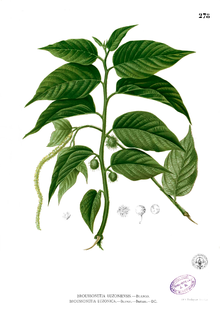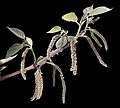Paper mulberry
| Paper mulberry | ||||||||||||
|---|---|---|---|---|---|---|---|---|---|---|---|---|

Ripe and unripe collective fruits of the paper mulberry tree ( Broussonetia papyrifera ). |
||||||||||||
| Systematics | ||||||||||||
|
||||||||||||
| Scientific name | ||||||||||||
| Broussonetia papyrifera | ||||||||||||
| ( L. ) Vent. |
The paper mulberry tree ( Broussonetia papyrifera ), also called paper mulberry or Japanese paper tree, is a species of the mulberry family (Moraceae), which also includes figs and mulberries . The generic name Broussonetia goes back to the French doctor, botanist and zoologist Pierre Marie Auguste Broussonet (1761-1807), who introduced the Linnaeus system in France.
The Japanese paper mulberry Broussonetia kazinoki is similar .
distribution
The natural range is in China , Myanmar , Thailand , Cambodia , Korea , Laos , Sikkim , Vietnam and Malaysia . It has been naturalized on many Pacific islands, in Japan and Taiwan for a very long time. The paper mulberry tree has meanwhile also become naturalized in southern Europe and in the southwest and southeast of the USA (planted there as a shade tree). In Ghana and Uganda , the plant is considered an invasive species . In Central Europe , the paper mulberry tree is planted as an ornamental wood .
description
Vegetative characteristics
The paper mulberry tree grows as a deciduous tree and reaches heights of 10 to 20 m, with a spreading crown. The trunk diameter can be up to 70 cm; it contains milk juice . The tree is very fast-growing, growing over 2 m in length and more than 2 cm in diameter per year. The bark, which is flat, longitudinally grooved, furrowed with age, is pale gray to light brown and yellowish at the base, but sometimes also striated or nubby. The bark of the twigs is initially green, then reddish-brown, later gray-brown and hairy.
The alternate and spirally arranged, dark green, lighter underside leaves are petiolate. The downy hairy petiole has a length of 2 to 8 cm. The simple, broad to narrow ovoid leaf blade is sometimes unequal in young plants, two- to five-lobed, with often deeper indentations (sinuses) and it is 6 to 20 cm long and 5 to 12 cm wide, it usually ends pointed, but also pointed or rounded. The underside of the leaf is hairy tomentose, the upper side sparse, but with a rough texture. The threefold network nerve is more or less impressed on the upper side and raised on the underside. The leaves are partly shaped like a shell or boat. The blade is partly unequal, the base is blunt to rounded or partly heart-shaped. The leaf margin is finely sawn or serrated forward. The two non-fused, egg-shaped, hairy, pointed and sloping stipules have a length of 1.5 to 2 cm and a width of 0.8 to 1 cm.
Generative characteristics
The flowering period extends from April to May. The paper mulberry tree has two separate sexes ( diocesan ), so there are purely male and purely female trees.
The purple to green-brownish, multi-flowered, mostly drooping, male inflorescences, which are located on a 2 to 4 cm long, hairy, green stem are catkins and 3 to 10 cm long and about 1 cm thick, with lanceolate, hairy, sloping bracts . The sitting male flowers are about 2 mm in size, they have four pointed, hairy tepals which form an overgrown perigon and four, about 3.5 mm long, stamens with basifix, whitish anthers.
The multi-flowered, compact and spherical female inflorescences ( false flowers ) sit on up to 1.5 cm long, green stems and have a diameter of about 1.5 to 2 cm. There are club-shaped, sloping bracts on the flowers. The female flowers have a tubular, virtually closed, hairy, minimally tetradentate and green, about 1.5 mm perianth that the pen is grown. The Upper constant, stalked, ovoid and unilocular ovary is about 0.7 mm. The long, filamentous and protruding styles are up to 2 cm long, light green or reddish to purple with a filamentous stigma . The long styles wither and then partially fall off and the spherical, green and hairy fruit heads remain.
Between June and July the light orange to brown, slightly wrinkled, egg-shaped to spherical, up to 4 mm large achenes , which are partly still clinging to the style, ripen in a fruit cluster (achenes cluster, achenosum) . The thousand grain mass is approx. 2 g. The achenes have grown into the tip of the up to 8 mm protruding, orange to red, lighter to the base, club-shaped and fleshy, with an edible, sweet but tasteless pulp, full-grown flower shell, of which only a membranous shell remains below ( False fruits ). The whole spherical fruit cluster has a diameter of 3 to 3.5 cm.
The number of chromosomes is 2n = 26.
It prefers well-drained, sandy soils and a sunny location. The preferred weather range is 12–30 ° C with a rainfall of up to 2500 mm / a. The tree can withstand somewhat longer dry seasons and short frosts and is very adaptable to the climate, but grows best in humid areas up to an altitude of 2000 m.
use
Furniture is made from light yellow to orange, light and relatively soft wood . The leaves, fruits and the bark are used in Chinese medicine.
The bark of this species and some other tree species is used to make bark fiber. (See also: tapa bark fiber )
Fibers from the bast layer of the paper mulberry tree were previously used for paper production in China, Korea and then later in Japan . As early as the 1st century AD, a fiber pulp was made from it in China, which, when mixed with paste, dried and smoothed, resulted in paper that was used for writing and for lanterns. It is assumed that the technique of making paper from the paper mulberry tree was also known in Korea from the 2nd century and was brought to Japan by a Korean monk in the 6th century. In Thailand (Siam) this type of paper production was later also known and called the paper Saa .
In South Korea , the traditional Korean paper Hanji is still made from it in a complex process and is used in a variety of ways.
The fruits and young leaves are edible.
Systematics
The basionyma of this species was first described as Morus papyrifera in 1753 by Carl von Linné in Species Plantarum 986. Further synonyms are e.g. B. Papyrius japonica Lam. , Papyrius papyriferus (L.) Kuntze , Papyrius polymorphus Cav. u. a. The valid name Broussonetia papyrifera (L.) Vent. was published in 1799 by Étienne Pierre Ventenat in Tableau du règne végétal selon la méthode de Jussieu , Volume 3, p. 547.
photos
Female flowers of Broussonetia papyrifera with long, protruding styluses - Freiburg Botanical Garden
Trunk with bark .
literature
- Zhengyi Wu, Zhe-Kun Zhou, Michael G. Gilbert: Moraceae in the Flora of China. Volume 5, p. 26: Broussonetia papyrifera - online
- Abdul Ghafoor: Moraceae in the Flora of Pakistan : Broussonetia papyrifera - online
- Richard P. Wunderlin: Moraceae in the Flora of North America. Volume 3: Broussonetia papyrifera - online
- George Watt: A Dictionary of the Economic Products of India. Volume 1, 1889, Cambridge Univ. Press, 2014, ISBN 978-1-107-23914-2 (Reprint), p. 538.
- John Lindley , Thomas Moore: The Treasury of Botany: A Popular Dictionary. William Wood, 1872, p. 172.
Web links
- Broussonetia papyrifera at carolinanature.com; with many pictures, accessed on July 28, 2017.
- Broussonetia papyrifera from Useful Tropical Plants, accessed July 29, 2017.
- Paper mulberry tree at Baumkunde.
Individual evidence
- ^ Georg August Pritzel , Carl Jessen : The German folk names of plants. New contribution to the German linguistic treasure. Philipp Cohen, Hannover 1882, p. 68, archive.org
- ↑ Helmut Genaust: Etymological dictionary of botanical plant names. 3rd, completely revised and expanded edition. Birkhäuser, Basel / Boston / Berlin 1996, ISBN 3-7643-2390-6 , p. 108.
- ↑ J. Mauremootoo, 2009: Biofuels and Invasive Species - Exploring the links between biofuel production systems and invasive species. IUCN background paper, p. 11 (PDF; 360 kB).
- ^ C. (Cornelis) C. Berg, EJH Corner, HP Nooteboom: Flora Malesiana. Series I: Seed Plants , Vol. 17, Pt. 2, 2005, Review in Taxon. 55 (1), 2006, p. 251, doi: 10.2307 / 25065564 .
- ↑ M. Brink, E. G Achigan-Dako: Plant Resources of Tropical Africa. 16: Fibers , Prota, 2012, ISBN 978-92-9081-481-8 , pp. 64-68, (online)
- ^ Michael G. Simpson: Plant Systematics. Second Edition, Academic Press, 2010, ISBN 978-0-12-374380-0 , p. 337.
- ↑ Vít Bojnanský, Agáta Fargašová: Atlas of Seeds and Fruits of Central and East-European flora. Springer, 2007, ISBN 978-1-4020-5362-7 , p. 39.
- ↑ Broussonetia papyrifera in the Flora of China .
- ↑ Broussonetia papyrifera in the Flora of North America .
- ↑ a b Hyejung Yum : Traditional Korean Paper Making . In: Scientific Research on the Pictorial Art of Asia . Archetype Publication Ltd. , London 2005, ISBN 1-873132-74-3 , pp. 75-80 (English).
- ↑ Broussonetia papyrifera at Kewscience, accessed July 28, 2017.








